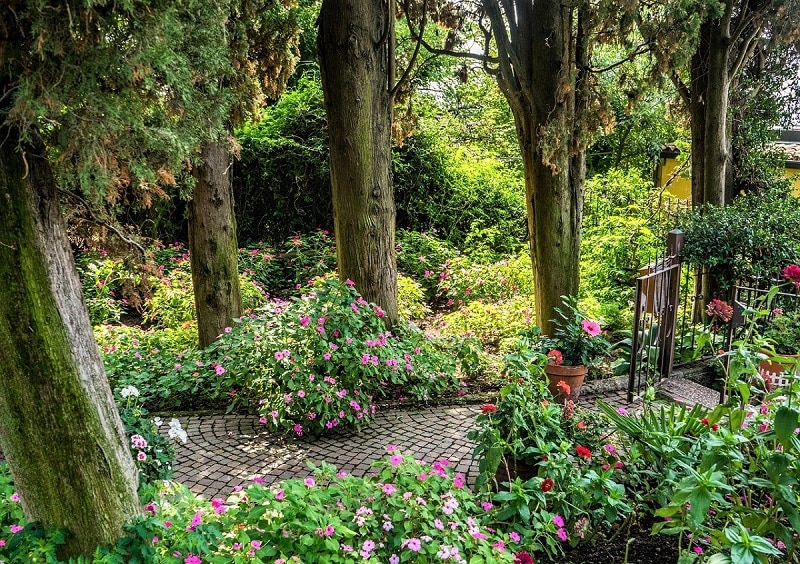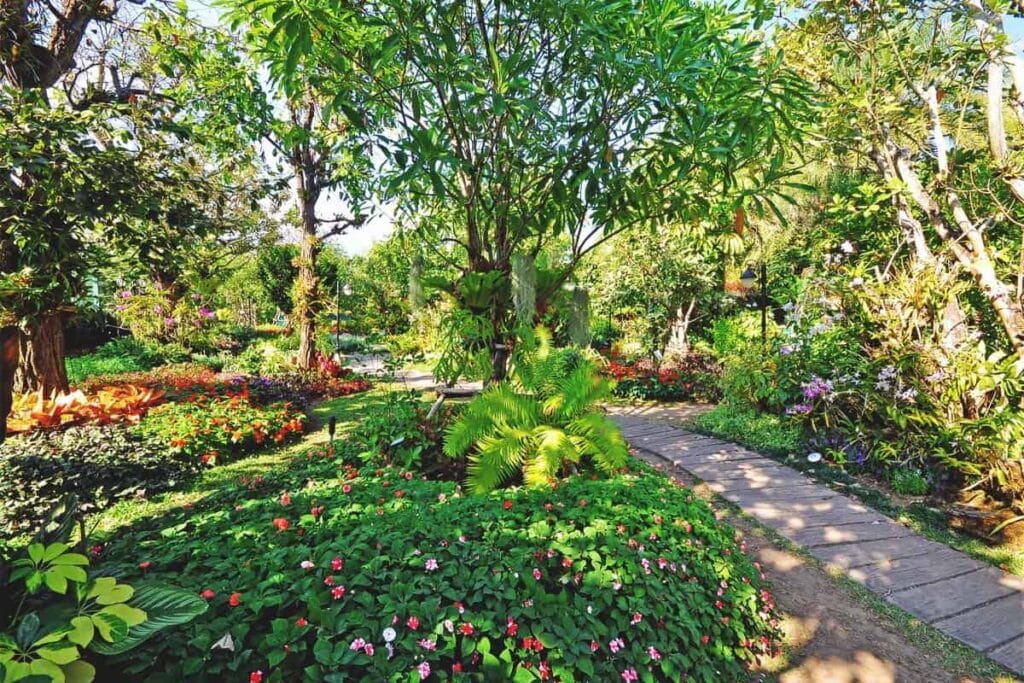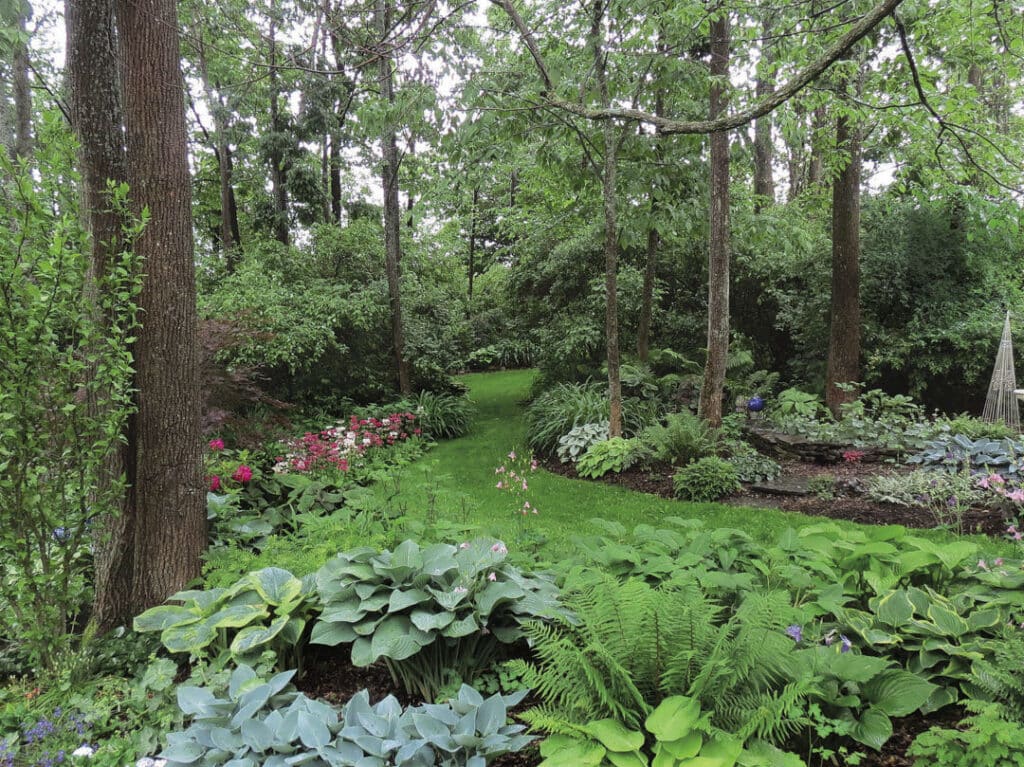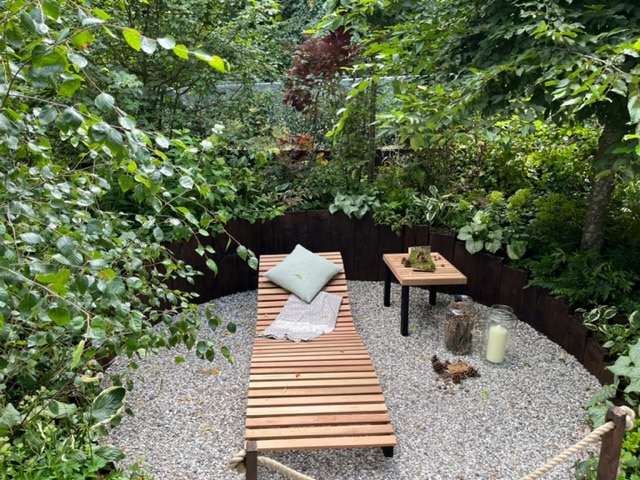Are you a nature aficionado and want to enjoy the magic of nature? With so many types of gardening techniques, ranging from spring gardens to courtyard gardens, forest gardening has paved its way due to its allure. The rustic and raw charm of plants and herbs growing on their own is a fascination for those who adore nature. The magic doesn’t just stop on rough elegance; it also entails the vibe of being in woodlands just outside your garden. So, do you want to enjoy the woodland charm right outside your home? Don’t worry, you’ve come to the right place. We are here with a detailed article guide on how to perfectly design a forest garden without much effort.

gardens.theownerbuildernetwork.co
Understanding Forest Gardening
A sustainable landscaping technique called forest gardening is modeled after natural ecosystems. It entails growing a wide variety of plants in layers that resemble a forest’s structure. Canopy trees offer habitat and shade, and the ground cover level is home to fruit trees and shade–tolerant plants. Both self-sufficiency and biodiversity are promoted by these food forests. A forest hill garden is a miniature ecosystem that can be made in a backyard forest by adding different plant layers. But careful planning is essential, considering space and sunshine. Moreover, consistent upkeep guarantees the yield and health of the garden. Besides, practicing forest gardening improves a person’s connection with nature and the environment.

Benefits of Forest Gardening: A Merge of Aesthetics and Functionality
When you talk about forest gardening, one should know that it comes with a lot of benefits to the community and the person himself. This section of the article will cover the detailed benefits of planting a forest garden in the backyard of the house.
1. Forest Gardening Promotes Biodiversity
Adding a variety of plant species like apples and pears in forest gardens creates a vibrant ecosystem that draws bees and beneficial insects and maintains ecological balance.
2. Soil Enrichment
In urban areas like New York City, the use of nitrogen-fixing plants in the ground cover layer improves soil fertility, lowering the requirement for synthetic fertilizers and enhancing overall soil health.
3. Forest Gardening Makes Urban Green Spaces
Establishing edible forest gardens in places like Station Square boosts the appearance of the city overall, provides oxygen, and helps with green infrastructure.
4. Community Engagement is Boosted with Forest Gardening
Initiatives such as gardening the forest promote social responsibility and social harmony by educating the community about sustainable gardening techniques.
5. Food Security
By offering a steady and varied supply of wholesome products, harvesting a range of fruits and nuts from forest gardens improves food security, particularly in areas with single-family homes.
6. One can Enjoy Economic Benefits Through Forest Gardening
Lowering food expenses and boosting property prices by enhancing urban areas like Russell Sage Foundation, as well as the creation of edible forest gardens, can benefit both individuals and communities economically.
7. Climate Resilience
Through the layers of organic mulch and dense vegetation, forest gardening reduces stormwater runoff, minimizes urban heat, and stores carbon dioxide.
8. Health and Wellness is Promoted by Forest Gardening
Lastly, Forest gardening maintains mental health, promotes physical exercise, and a sense of connection to the natural world, all of which improve people’s general health and quality of life.
Besides, forest gardening has social, economic, and health benefits in addition to environmental sustainability, making it an integrated approach to urban greening and community development. Furthermore, incorporating the ideas of forest gardening into urban design and policy can result in more fair and resilient cities for coming generations. Lastly, through the use of forest gardening, people and communities can benefit from a thriving and sustainable urban ecology while taking a proactive approach to addressing urgent environmental and social issues.

Key Elements of Forest Gardening
Let’s discuss the key elements of forest gardening to better understand the concept.
1. Canopy Layer in Forest Gardening
- Trees in the canopy layer, like those suggested by Martin Crawford, give the forest garden shade, habitat, and vertical structure.
- The first step in creating a forest garden is to choose suitable canopy species, such as fruit or nut-bearing trees, which provide the ecosystem’s overall framework.
- Planting in the forest: The canopy layer provides shade for the understory and wildlife habitat. It then results in a cool, damp microclimate that is advantageous for other plants.
- Canopy trees are essential to the overall health of the ecosystem and store carbon in hills gardens, in addition to yielding fruits and nuts.
2. Understory Layer
- The understory layer is made up of Shrubs and smaller trees, which provide the forest garden with more diversity and production.
- Food forests, which provide a range of fruits, berries, and medicinal herbs, are supported by the diversity of understory plants.
- Although less prominent than canopy trees, the understory layer is essential to the forest garden’s optimal use of space and nutrients.
- Creating a forest garden entails choosing species for the understory that can withstand shadow. Moreover, they also guarantee the effective utilization of sunshine and resources.
3. Ground Cover Layer: Important Element in Forest Gardening
- Ground cover plants, such as perennial vegetables and low-growing herbs, shield the soil from weeds and add more food sources.
- Martin Crawford highlights the value of ground cover in forest gardening because it reduces soil erosion. It also enhances soil moisture retention.
- In addition to promoting biodiversity, the ground cover layer serves as a living mulch, lowering the demand for artificial fertilizers and irrigation.
- Although it is frequently disregarded, the ground cover layer is essential to the development of a robust and self-sustaining ecosystem in forest gardens.
4. Vertical Layer: Aesthetic Element of Forest Gardening
- Vines and climbers make use of vertical space to increase the forest garden’s potential for productivity.
- Hills gardens benefit from covering walls, trellises, or arbors with vertical plants to create more growing space.
- By adding a vertical layer to your forest garden, you may attract a greater variety of beneficial insects and birds and enhance the overall diversity of habitats.
- However, meticulous planning is required to avoid competition and congestion among the forest garden’s vertical plants.

Tips for Backyard Forest Garden
Here are some tips to follow if you wish to do gardening in the forest. From trees and shrubs to carefully planting in the forest, you can achieve a rustic charm in your home.
Site Assessment: To choose the right plants, consider drainage, soil condition, and solar exposure.
Design Planning: Draw a layout considering the requirements for maintenance, plant compatibility, and space arrangement.
Plant Selection: Select a wide range of native or climate-adapted plants, such as perennial vegetables, berries, and fruit trees.
Implementation: As the garden matures, start carefully with important plantings and gradually add more.
Maintenance: To keep gardens healthy, regular chores include watering, mulching, pruning, and insect control.
Observation: To adjust and improve the garden over time, keep a close eye on wildlife interactions, soil conditions, and the growth of plants.
Permaculture Principles: To build a robust and low-maintenance ecosystem, embrace ideas like diversity, minimal interference, and collaboration with nature.
You can also check the detailed steps to create a forest garden here.
Conclusion
Summing up, this article covered the concept of forest gardening in detail. The benefits of planting a forest right outside your home are also mentioned. If you are a nature lover, we have provided you with some steps to consider when deciding to create a forest landscape.
Create a Healthy Atmosphere!
